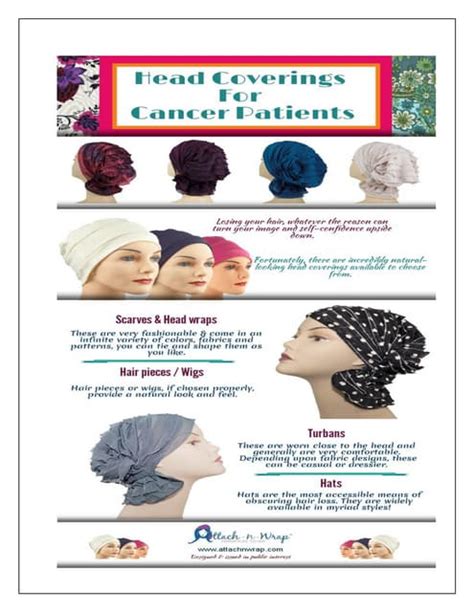Cancer treatment can have a profound impact on a patient’s physical and emotional well-being. One common side effect is hair loss, which can be a difficult and emotionally challenging experience. Head coverings can provide comfort, privacy, and a sense of normalcy during this time.

10 Must-Know Facts About Head Coverings for Cancer Patients
- Over 2 million people in the US undergo cancer treatment annually, many of whom experience hair loss.
- 1 in 8 women will develop breast cancer in their lifetime, which often requires chemotherapy and radiation therapy that can lead to hair loss.
- Hair loss can be a significant source of distress for cancer patients, affecting their self-esteem and quality of life.
- Head coverings can help patients cope with hair loss and maintain a positive body image.
- There are numerous types of head coverings available, including wigs, hats, scarves, and turbans.
- The choice of head covering depends on individual preferences, comfort level, and the patient’s stage of treatment.
- Head coverings can be made from various materials, such as cotton, silk, bamboo, and synthetic fibers.
- Proper care and maintenance of head coverings is essential to ensure hygiene and longevity.
- Head coverings can be a source of support and solidarity among cancer patients.
- Patients should feel empowered to experiment with different head coverings to find what works best for them.
Types of Head Coverings for Cancer Patients
Wigs:
- Made from natural or synthetic hair
- Provide a realistic and stylish alternative to natural hair
- Can be customized to match the patient’s hair color, texture, and length
- Require professional fitting and styling
Hats:
- Available in a wide variety of styles, from baseball caps to sun hats
- Offer privacy and protection from the elements
- Can be easily removed and adjusted
- Some hats are designed specifically for cancer patients, with soft linings and adjustable bands
Scarves:
- Versatile and comfortable
- Can be worn in various ways, including as a headband, headscarf, or turban
- Made from lightweight and breathable fabrics
- Allow for easy access to medical devices
Turbans:
- Traditional head coverings worn in many cultures
- Provide full coverage and a stylish alternative to wigs
- Available in a variety of materials, colors, and patterns
- Some turbans are designed with additional features such as built-in caps or pockets for hair loss accessories
How to Choose the Right Head Covering
- Consider the stage of treatment: Wigs may be a better choice for patients who have permanent hair loss, while hats or scarves may be more suitable for temporary hair loss.
- Think about comfort: Choose head coverings made from soft, breathable materials that won’t irritate the scalp.
- Match your style: Head coverings come in a variety of colors, patterns, and styles to complement the patient’s personal taste.
- Accessorize: Head coverings can be accessorized with hairpins, headbands, or turbans to enhance the look.
- Don’t be afraid to experiment: Try on different types of head coverings to find what feels most comfortable and flattering.
Tips and Tricks for Wearing Head Coverings
- Start with a clean and dry scalp. This will prevent irritation and ensure a secure fit.
- Use a wig cap or band. This will help keep the wig in place and prevent friction against the scalp.
- Secure the head covering with bobby pins. Use enough pins to keep the covering in place without causing discomfort.
- Adjust the fit. Make sure the head covering is not too tight or too loose.
- Consider your lifestyle. Choose head coverings that are appropriate for your daily activities and preferences.
Common Mistakes to Avoid
- Wearing head coverings that are too tight. This can cause discomfort and scalp irritation.
- Using harsh chemicals or detergents to clean head coverings. This can damage the materials and irritate the scalp.
- Not washing head coverings regularly. This can lead to the accumulation of bacteria and unpleasant odors.
- Being discouraged by hair loss. Hair loss is a common and temporary side effect of cancer treatment. There are numerous stylish and comfortable options available to help patients cope with this challenge.
Conclusion
Head coverings can provide comfort, privacy, and a sense of normalcy for cancer patients experiencing hair loss. By choosing the right head covering and following proper care and maintenance guidelines, patients can confidently and stylishly navigate this challenging aspect of cancer treatment.
